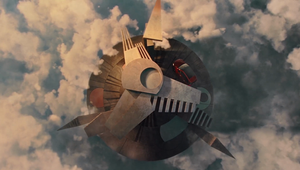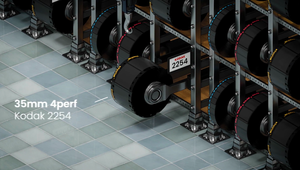
With DFD, Cinelab Film & Digital Offers Filmmakers the Best of Both Worlds

Try as it might, digital still can’t produce the warmth, depth, and that oh-so-enviable grain that happens effortlessly on film. “The aesthetic of film is something cinematographers and colourists have tried to emulate in digital photography since it became popular in the early 2010s. The advantages of better monitoring and longer roll times during digital acquisition can be appealing to certain productions and help balance the books if higher shooting ratios are required, but the overall organic nature of film and its distinct look is still unrivalled and still sought after by many DOPs,” Adrian Bull, Cinelab's CEO, has previously told LBB.
It should be noted that sometimes the ‘full’ celluloid aesthetic isn’t the right one for every project, particularly those trying to swerve any associations with nostalgia and are instead aiming for the cleanness that digital provides. DFD (that’s digital to film to digital) is a process filmmakers can opt for when they want to give their digitally-shot footage the desired qualities of film-captured action or add a controlled amount of it to certain shots and scenes. DFD “can have quite a dramatic impact on changing the otherwise very clinical digital look,” Adrian adds.
It’s a technique that’s utilised fairly often on short form projects - ads and music videos - though recently TV shows and features have also been making use of it too. It’s also a technique that gives filmmakers - directors, DOPs - the best of both worlds, marrying the technology that has stood the test of time with its cutting edge digital sibling. Cinelab Film & Digital’s in-house capabilities span the ability to authentically reproduce the grain size and look of full frame 35mm, Super 16mm, or Super 8mm for digital footage, giving filmmakers multiple aesthetic options to utilise as needed.
Today, LBB takes a look at some of Cinelab’s most notable DFD projects and what aesthetic benefits it brought to the final projects with insights from directors Oscu and Alan Masferrer.
Jacques, ‘Absolve’
Set in the Louvre museum, the video for the French alt-pop artist Jacques quickly takes a turn for the surreal. Director Paul Trillo takes viewers on a strange trip inside the video protagonist’s mind as he follows a cosmic teardrop around the museum. Classic artworks are presented in a new, unexpected light through experimental visual sequences. To achieve the look, Paul combined a number of techniques across VFX and CG; he also opted for assistance from AI image making technology. It was all brought together via DFD with the oldest image making technology, film, unifying a host of cutting-edge tools.
Mercedes-Benz, ‘Hi, Life’
CG, VFX, and DFD come together in this dreamlike spot for Mercedes-Benz, directed by Alan Masferrer. Alan’s preference is to shoot on film, he’s shared with LBB, but for this production the attention had to be on the elaborate build of the set. Still, he wanted to give the final spot that filmic look and DFD was the way to do it. “I love organic textures and would primarily shoot on film if it were feasible for production. However, for the Mercedes-Benz film, my focus was on the set - building it and making all its movements real to make that surreal world as tangible as possible. This made shooting on film non-viable, especially since we had to post-produce nearly every shot to create the cloudy environment, so we opted for digital,” says Alan.
Colourist Emiliano Serantoni, whom Alan calls “brilliant”, suggested “transferring the final edit to celluloid film and then scanning it back to digital (DFD)” during the grading process. “I hadn't considered this before because I always prefer an honest visual approach, and it initially felt like a trick. But in this case, it made perfect sense to unify the organic texture of what we captured in-camera with all the clouds and skies added in post-production. We chose 35mm and 250D film stock because it felt like the most balanced option. I ended up loving the subtle touch it added, particularly how it softened the image and created a natural halation effect - something that often feels forced when done digitally but, overall, I think this process only makes sense for certain specific projects,” Alan explains.
NBA, ‘The Heist’
With the actor Michael Imperioli (of ‘The Sopranos’, ‘Goodfellas’, and ‘The White Lotus’ fame) in the lead role, it would be easy to mistake NBA’s ‘The Heist’ for an actual film trailer. It certainly looks like a classic heist film, replete with the gloss of Las Vegas’ casinos and heart-racing tension, plus it looks the part too with its deep hues and velvety textures. All the aesthetic clues point to this being shot on film but the reality is that the final look was thanks to the DFD process, illustrating its nuanced capabilities.
‘SLUSH’
'SLUSH' is the artful short from director Oscu. The fully CG short was created with 4D scans to capture the models’ performances before adding them to the CG world. All this tech and yet the shots feel textured, touchable - the rocks are grained and the abstract transitions are reminiscent of life magnified under a microscope. Oscu opted for DFD to give SLUSH “a more analogue feel, countering the often cold and perfect look of CG animation. The DFD process adds a layer of subtle imperfections and grain that enhance the texture and depth of the image, this helped us achieve the warm realistic look that we were after.”
For Oscu, 16mm was the right format. “As our overall visual style was quite minimalistic, we specifically decided to use 16mm print to introduce a rougher grain, in contrast to the smoother look of 35mm film. This helped to really soften the clean edges of our renders. When creating the actual animation we utilised a technique known as 4D volumetric scanning to capture our models’ performances, which we then integrated into our CG environment. The combination of this technique with the DFD process resulted in a unique and special look that we are super excited about.”
“Personally I am passionate about pushing CG animation toward a photorealistic style, and DFD is a subtle but very powerful technique to give more emotion to the image,” Oscu adds.
FIGS, ‘Anatomy of a Champion’
Pain, struggle, the visceral details of a body in motion - communicating the reality of all of this on screen is not easy. A recent campaign for FIGS, ‘Anatomy of a Champion’, depicts real medical staff helping athletes prepare for and recover from training and competition. It’s an unflinching look at the paces athletes put their bodies through, plus the injuries and setbacks they inevitably encounter. These themes are further visually communicated through the film’s finish, finely grained and almost touchable, which was achieved with DFD.
Jorja Smith, ‘Feelings’ (feat. J Hus)
It’s fitting that the music video for a song titled ‘Feelings’ would eschew the cold and clean aesthetic of digital in favour of the subtle warmth and intimacy of film though the effect was achieved through DFD. The video, directed by Femi Ladi, is a cinematic retelling of the Bonnie and Clyde story with Jorja and actress Jasmin Jobson playing a number of characters executing heists in visually arresting costumes and settings that are made all the more sumptuous through DFD enhancement.
RM, 'LOST!'
The experimental music video for RM’s ‘Lost’ is a weird and wonderful pleasure to watch. Directed by Aube Perrie and with cinematography from Christopher Ripley, the promo depicts RM trapped in a maze-like structure and looking for a way out across various rooms and floors reminiscent of the details in an M.C. Escher drawing. RM eventually finds his way onto a retro-styled talk show set bathed in rich autumnal tones. The video recently won a ‘Best Cinematography’ award at the Berlin Commercial Festival.
Christopher says that he wanted “to give this project a more human viewpoint by using film” as the visuals feature “a lot of geometric, minimalist environments shot on sharp contrast-y lenses. Much of the video involves fragments of sets and isometric angles of miniatures surrounded by nothingness. This could easily feel a bit too clinical.”
But shooting the video in the preferred format, 35mm, was impossible “due to schedule, budget, and the extent of post production work - but Cinelab’s DFD process gave us exactly what we needed. The content of each frame remained precise and clear, but the foundational fabric of the image felt photochemical instead of digital, with subtle halation, grain, colour shifts, low pass, and local contrast. While it’s possible to emulate all of these things digitally, the DFD process achieves it physically - and because of that I find the results tend to be more holistic and complex,” he explains.
“Our VFX team did a fantastic job compositing miniature and full-scale elements together, and DFD was a lovely final step to smash those composites together onto a film emulsion. It has a nicely unifying effect. In a way, it allows you to ‘shoot your virtual environments on 35mm after they are created!” adds Chris.















